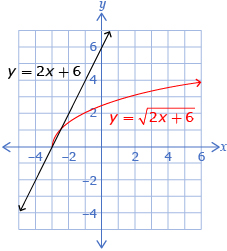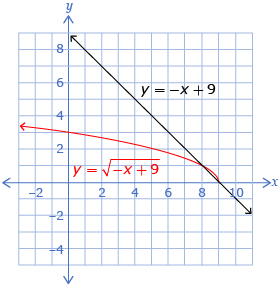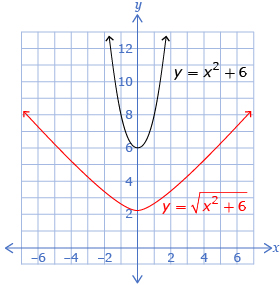Module 2: Lesson 2
Self-Check 2
Questions 5.b. and 5.c. and questions 6.b. and 6.c. from “Practise” on page 87
-
The two equations can be graphed as follows:

For y = 2x + 6:
Domain: {x|x ∈ R} Range:
{y|y ∈ R}
In graphs of square root functions, the domains of the square root functions are restricted. Any portion of the original graph that lies below the x-axis will not appear in the graph of the square root function. In this case, as seen on the graph, y < 0 occurs when x < −3. As a result, for

Domain: {x|x ≥ −3, x ∈ R} Range:
{y|y ≥ 0, y ∈ R} -
The two equations can be graphed as follows:

For y = −x + 9:
Domain: {x|x ∈ R} Range:
{y|y ∈ R}
In graphs of square root functions, the domains of the square root functions are restricted. Any portion of the original graph that lies below the x-axis will not appear in the square root graph. In this case, y < 0 occurs when x < 9. As a result, for

Domain: {x|x ≤ 9, x ∈ R} Range:
{y|y ≥ 0, y ∈ R}
-
-
The two equations can be graphed as follows:

For y = 2 − x2:
Domain: {x|x ∈ R} Range:
{y|y ≤ 2, y ∈ R}
In graphs of square root functions, the domains of the square root functions are restricted. Any portion of the original graph that lies below the x-axis will not appear in the square root graph. In this case, the y-values are less than zero when
 and when
and when  This corresponds to all of the points when y < 0. The range also has an upper limit, however; in the original graph, the maximum occurs at y = 2. In the square root graph, the maximum value will be the square root of the maximum value (because this maximum value is above 0). As a result, for
This corresponds to all of the points when y < 0. The range also has an upper limit, however; in the original graph, the maximum occurs at y = 2. In the square root graph, the maximum value will be the square root of the maximum value (because this maximum value is above 0). As a result, for 
Domain: 
Range:

-
The two equations can be graphed as follows:

For y = x2 + 6:
Domain: {x|x ∈ R} Range:
{y|y ≥6, y ∈ R}
In graphs of square root functions, the domains of the square root functions are restricted. Any portion of the original graph that lies below the x-axis will not appear in the square root graph. In this case, however, there are no points where y < 0. There is a minimum on the range in the original function, however; because this minimum is above the y-axis, the new minimum will be the square root of 6. As a result, for

Domain: {x|x ∈ R} Range:

-
© 2012 Alberta Education